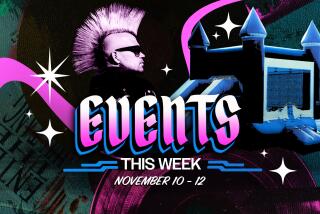Marching to a Different Strummer
At the age of 6, Gabe Whitcher clambered up on a chair to play a sprightly fiddle version of an old Texas swing tune, “Take Me Back to Texas--I’m Too Young to Marry,” and won third place in the 1986 Topanga Banjo/Fiddle Contest intermediate category. He was already a contest veteran, having won first place in the beginners’ category when he was 5.
Young Whitcher, who plays fiddle to his father Dennis’ mandolin in the Whitcher Brothers band, went on to win first place in intermediate fiddle in 1988.
Hopes to Repeat
He hopes to repeat this year at the 29th Topanga Banjo/Fiddle Contest and Dance & Folk Arts Festival on Sunday from 9:30 a.m. to 6 p.m. at El Camino College, 16007 S. Crenshaw Blvd. Admission is $5 for adults, $2 for senior citizens and ages 12-17 and free to children under 12.
“We want everybody of all ages and all levels of achievement to participate,” says Dorian Keyser, chief organizer of the event since 1969. “The tradition of this event is that people start as kids and stay with (the contest) for years and years.”
Keyser says, for instance, that “legendary bluegrass banjo player” Pat Cloud, who has been coming to the contest since he was a teen-ager, will return this year to play with Yankee Bluegrass, one of five professional bands that will play in addition to the contestants.
Stuart Duncan, 25, whose bluegrass fiddle playing can be heard on four of five 1989 Grammy-nominated bluegrass albums, started coming to the contest when he was 11 and has been back many times since, according to Keyser. Other noted contestants have included David Lindley of El Rayo, Ry Cooder, Taj Mahal, Jackson Browne and Steve Martin.
About 100 contestants will compete in fiddle, banjo, singing, guitar, mandolin and band categories at this annual event, which began in Topanga Canyon in 1960 and has moved to various locations before arriving at El Camino in 1986. Individual instrumental categories are divided into beginning, intermediate and advanced contestants.
Banjo is also divided into bluegrass and traditional banjo. Singing is divided into traditional and harmony. Keyser, who plays guitar and banjo, says a traditional song is one that’s been in the “oral pipeline” since at least 1940. Harmony, however can include everything from modern bluegrass to traditional songs.
Traditional or old-time banjo is also called frailing or claw hammer, because musicians hold one hand like a claw and hit down, striking the strings with their fingernails. In contrast, the newer bluegrass style, popularized by musician Earl Scruggs, uses finger-picking patterns to create an individual note style.
And you don’t have to be a contestant to get a chance to play. A special area is set aside for people who bring along their banjos, guitars or fiddles for impromptu jam sessions with other musicians.
In addition to competitive groups, Iron Mountain String Band, Crossroads, Grey Eagle and Black Label String Band will also appear.
Meanwhile, the dance stage is the site of demonstrations of New England contra dancing, square dancing, Scottish country dancing, clogging and international dances.
‘Dance All Day’
“People can come in the morning and dance all day,” says Mary Ellen Clark, a kindergarten teacher, guitarist and Scottish country dancer.
Contra dancing is performed to “hoedown music,” and dancers stand in two lines facing each other. The steps are easy to learn and the dance “can go on for a long, long time, depending on how enthusiastic the dancers are and how long the musicians want to play,” Clark says.
Scottish country dancing is “the official ballroom dancing of Scotland,” according to Clark. The formation is similar to contra dancing, but footwork is much faster and more intricate, including a skip step, a pas de Basque (leaping step), and sometimes even Highland dance steps.
Clogging had its origins in the Appalachian Mountains and includes elements of tap and fleet-footed Irish dancing. “This is something that people would do when they played real lively tunes and there were no other dances to ‘em so they just got up and clogged,” Clark explains.
In addition to the music and dancing, there’s also a folk arts fair with a variety of handcrafts, including weaving, ceramics, needlework, jewelry, wood carving and leather craft.
“This is the basic American culture that goes back to the origins of people in this country, and so come and hear what it’s like,” Keyser says. “Our whole idea is to bring a picnic basket, spread your blanket out and enjoy the music.”
El Camino Community College is south of Torrance and east of Gardena. The school is bordered by Crenshaw Boulevard on the east, Redondo Beach Boulevard on the south and Manhattan Beach Boulevard on the north. Parking is available at the corner of Crenshaw Boulevard and Redondo Beach Boulevard. For information, call (818) 594-1742.
More to Read
The biggest entertainment stories
Get our big stories about Hollywood, film, television, music, arts, culture and more right in your inbox as soon as they publish.
You may occasionally receive promotional content from the Los Angeles Times.








